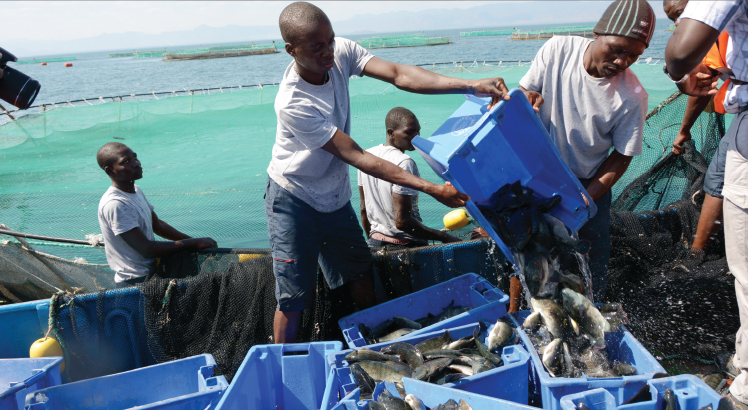For the past five years, I have been advocating for improved fish farming in Malawi. I have made several presentations in Asia and Europe with a deep emphasis that aquaculture, in this case, meaning fish farming in Malawi, has the potential to change the livelihoods of poor Malawians if the sector gets enough support from the Government of Malawi and the private sector.
It is a well-known fact that there are some fears about the aquaculture sector, especially about the environment.
Some of the fears are that fish farming can result in drying up streams and forest degradation. However, facts have shown that when a country advocates for sustainable aquaculture, the fear of environmental degradation is not an issue to lament.
Aquaculture has enormous potential for developing countries because it intersects with Sustainable Development Goal 14.7. The United Nations recognises that aquaculture has the potential to transform the economies of the world’s least developed countries. International trade statistics have also shown that the aquaculture sector has a high-level of revealed comparative in Malawi.
Aquaculture has the potential to boost the country’s socio-economic development
This means the sector has the potential to grow and improve the economy of a particular nation. It is evident that fish farmers in Malawi face many challenges such as lack of access to credit, lack of support from institutions, poor fingerlings and the unavailability of better markets.
Most farmers also face post-harvest issues such as poor handling of fish because refrigeration facilities are expensive, resulting in fish losses and transportation is also expensive. Aquaculture has previously been shown to be an effective tool for improving people’s livelihoods in developing countries. I will go into detail about how the aquaculture sector benefited Bangladesh, a poor country.
As a result, Bangladesh is endowed with vast marine, brackish and inland waters that are rich in fisheries resources. The contribution of fisheries to Bangladesh’s national economy is significant, particularly in terms of food consumption, nutrition, employment and exports.
In 2013-14, the fisheries sector contributed approximately 23.12 percent of agricultural gross domestic product (GDP), 3.69 percent of total GDP and 2.01 percent of the country’s export earnings.
The sector’s contribution to the national economy is much greater than its 4.39 percent share of GDP as it provides approximately 60 percent of animal protein intake and more than 11 percent of the country’s total population is directly or indirectly involved in this sector for a living.
During 2018/19 season, total fish production was estimated to be 3.41 million tonnes, with inland and marine fisheries accounting for 83 percent and 17 percent of total catch, respectively.
Fish is the third largest contributor to Bangladesh’s export earnings and is growing annually by eight to 10 percent. Bangladesh earned $630.24 million from the export of fish and fish products in 2013/14 season.
Fish products are gradually outpacing revenue from non-fish agricultural exports to the point where fish has become the most important primary commodity exported by Bangladesh. This sector’s growth rate has been almost constant and encouraging over the last 10 years, ranging from 4.76 to 7.32 percent on average.
This industry employs about 12 million people directly or indirectly. This sector’s labour employment has been increasing at a rate of about 3.5 percent per year. Bangladesh has an abundance of water resources, including ponds, natural depressions, lakes, canals, rivers and estuaries. In terms of water resources, it ranks third in the world, trailing only China and India.
Even with minimal investment and time, the fisheries sector is profitable. Many fish farms and hatcheries have recently been established with government and private sector investment. Expansion and productivity are relatively easy to achieve in these activities, which have an impact on socio-economic development, food security, poverty reduction and job creation.
Bangladesh, as an agrarian country, is focusing on agricultural diversification, with the contribution of the fisheries sector gradually increasing.
As the fish production from aquaculture has increased remarkably over the last few years, many of the poor and ultra-poor of rural Bangladesh have got the opportunity of full-time and part-time employment. About 11 percent of the country’s population now directly or indirectly depends on the fish sector for their livelihood. Women account for 10 percent of the workforce in the fishing industry. Furthermore, women make up 80 percent of workers in fish processing plants and fish drying centers.
Aquaculture systems are classified into three types: (i) extensive systems that rely solely on natural food produced in the water body; (ii) semi-intensive systems that rely primarily on natural feed but are supplemented with feed and fertiliser; and (iii) intensive systems that rely solely on nutritionally complete concentrated feed and fertilisers. In some parts of Bangladesh, aquaculture has grown rapidly.
Of the total pond area, 90 percent is reported to be in use for fish production.
The main species are Indian major carps: rohu (Labeo rohita), catla (Catla catla), mrigal (Cirrhinus cirrhosus), exotic carps: silver carp, common carp and catfish: Thai pangas (Pangasius hypophthalmus), all contributing five percent or more to the total production.
Other common aquaculture species are bighead carp, mirror carp, and silver barb. The latter three are all introduced species. The contribution of tilapia, primarily Nile tilapia and also Java tilapia, Oreochromis mossabicus, is growing but is still reported to be just 1.5 percent of the total. In the publicly managed oxbow lakes, the exotic carps (silver carp, grass carp, common carp, and also bighead carp) make up 46 percent of the total production followed by the major carps with 13 percent. The composition is more varied in the privately managed oxbow lakes, where exotic carps make up 56 percent and major carps, 22 percent of the production.
From what we have seen from the Bangladesh scenario, Malawi has the potential to emulate Bangladesh. There is potential to improve the aquaculture value chain so that the industry can grow into a better industry.
The Government of Malawi can remove some transaction costs related to fish farming, help farmers access credit and find better markets for our fish.
Facts have shown that some industries that Malawi has been depending on are now tired, and aquaculture needs proper attention.
The post Aquaculture has potential to improve lives appeared first on The Nation Online.
 Moni Malawi
Moni Malawi 

